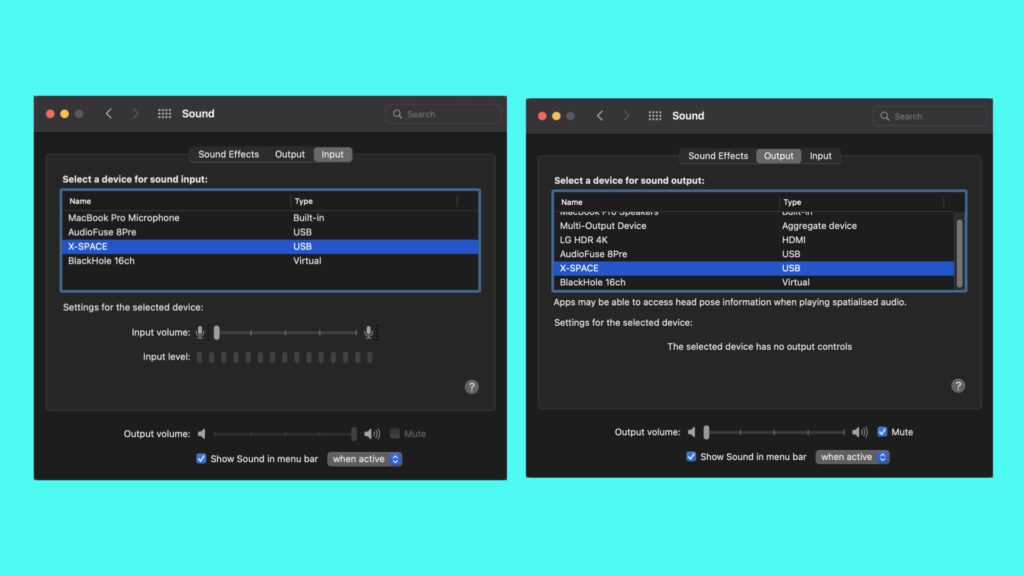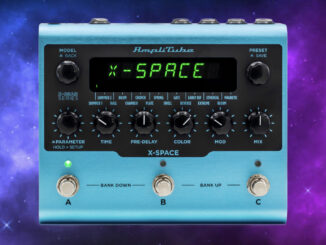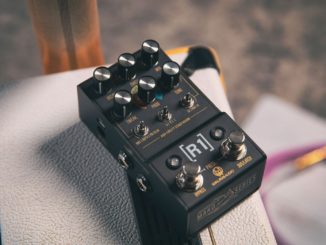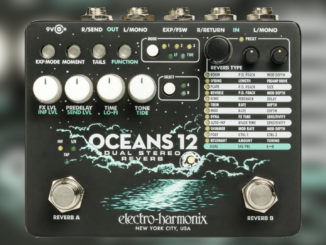IK Multimedia X-SPACE review: a modern, rock-solid built stereo reverb pedal packed with DSP power that harmonises perfectly with synthesizers.
In mid-2021, the Italian company IK Multimedia presented the X-Gear range, its first-ever hardware effect pedals. A distortion, modulation. delay and reverb. All with state-of-the-art DSP power and packed modern features with some interesting extras.
Disclaimer: IK Multimedia sent over a X-SPACE the digital stereo reverb for making an in-depth review. Of course with synthesizer and electronic sounds.

Unboxing
The pedal comes in a beautiful light blue cardboard box. Once unpacked, you can find the pedal, a matching 9V power supply, and a card with a serial number. Positive to see is that it comes with a power supply.
Connectivity
All connections are on the back of the pedal. The AmpliTube X-Space works in true stereo and can also thus process stereo input signals. Of course, it also works with a mono to stereo signal flow. On the back, you can find two 6.3mm inputs and two outputs, a MIDI interface with in/out with classic sockets, no dongles, and a socket for an expression pedal or foot switch.

There is also a USB connection for different functionalities and a 9V DC power supply connection. As I already said, the matching unit is included in the box.
User interface
5 potentiometers, 3 endless rotary encoders, 3 switches and an easy-to-read display form the framework of the user interface. The three encoders have an additional push function, one initiates the preset storage process, one is for algorithms + back function and the latter one manages the sub menu. Then the five simple pots set the main parameters: time, pre-delay, color, mod, and mix.
X-Space has three multi-functional switches: on the one hand you can switch the effect on/off in the classic way. On the other hand, you can navigate through the sound banks A + B together is bank down and B + C bank up. Don’t forget to explore this functionality, otherwise you will overlook the majority of the built-in presets. There are also different LEDs that shows you in which operating mode you currently are: preset active, preset edited, or bank browsing.

Classic potentiometers are used for the main parameters. I would prefer endless rotary knobs for this section, since they allows you to change parameters more exactly. More precisely, if you tweak a parameter on the X-Space, it often happens that the edited value changes deeper in the positive or negative way. A catch function would be useful here so that you start tweaking where the parameter in the actual preset actually is. Or is there such a mode that prevents parameter jumps?
The display is a bit old-fashioned, but is very easy to read, colored and bright. In times of large touch display pedals, a neat different concept.
“Click there, then there again…”, yes the operation is initially a bit fiddly and irritating. This applies above all to calling up the sub parameters and managing presets. Over time you understand the concept and you know the important steps.
Algorithms
Internally, the X-Gear series works digitally with a DSP chip that converts the signal to 24-bit/192kHz with a frequency response of 5Hz – 24kHz. IK Multimedia has put on this core a wealth of interesting algorithms. There are a total of 16 different ones, all with many parameters and so very extensively customizable. From classic to modern and unusual, there is something for everyone:
- Shimmer 1: a complex shimmer with increasing feedback
- Shimmer 2: a complex shimmer without increasing feedback but with two different pitched voices
- Hall: emulation of a live concert hall with controlled decay and reverb time (up to 9 seconds).
- Room: This model (up to 3 seconds) adds the third dimension of a room to the direct sound in order to place it in a physical space and obtain a more natural sounding. performance. Thanks to the 3-band decay trimmer any room can be recreated giving infinite possibilities.
- Chamber: typical chamber sound found in many pro recording studios with a super flexible reverb tail up to 9 seconds and some extras.
- Church: typical reverb sound found in churches with the longest tail up to 20 seconds.
- Plate reverb with up to 5 seconds and featuring different parameters for creating a wide range of vintage-inspired plate reverbs.

- Spring: advanced spring modules emulations found in guitar amps.
- Swell: customizable fading swell effects meets reverb.
- Gate: a customizable gated reverb.
- Reverse: made for creating reverse delay trails with a reverse envelope with three modes.
- Early-Ref: emulates the typical short reflections that can be heard in a small room or space.
- Extreme: a plate reverb that is modulated by a vintage phaser to add extreme modulated tails.
- Ethereal: highly modulated plate for moving airy trails.
- Bloom: a well like effect reverb that adds movement and vibe to your sounds.
- Magnetic: a spatial reverb with an airy tone.
The mix offered here is fun. Ethereal and Magnetic in particular can produce beautiful, lush ambient tones. The two shimmer reverbs on the of the list are solid, sound very good but are not epic as one from Strymon or ValhallaDSP. I was positive surprised by the Early-Ref and the Extreme algorithm, which make very special reverb tones possible.
On the other hand, Hall, Room, Chamber, Church… are very classic and bread and butter reverbs. The quality is very high and one of the best hardware I’ve played so far. The Swell algorithm is also a lot of fun especially useful to add a moving space to your sounds.
16 are already a lot of programs. But I hope that IK Multimedia will add a second bank of algorithms like a granular reverb, a distortion + reverb combo or one that goes in the Lexicon direction

Plus, it hosts a cabinet simulator with five different IR-based cabinets. A feature for the guitarists and bassists.
The X-FACTOR
The name of the pedal is not accidental. It has an X-mode “X factor”, not the casting show, that activates a special functionality. It adds an almost endless tail length to the reverb algorithm in most cases. In the gate program, it engages the maximum time and size producing a dramatic timbre change.
Great to make big epic ambient drones or to let a sound disappear in a cloud at the end of a track. You can activate it by holding the footswitch while the preset is on.
Librarian
The X-SPACE pedal has 300 memory locations for presets that arranged into 100 banks of three presets each (A, B, C). The presets can be selected using the footswitches. That’s a lot of space for your own patches. For the preset management (import/export), IK Multimedia ships the pedal with a free X-GEAR librarian software that also a firmware update functionality.

The librarian is however, not a fully-featured editor software, but I don’t think you need one because there aren’t that many parameters available. This can also be downloaded without registration, but there are good reasons to register your pedal.
AmpliTube Software Version
Registering hardware in the IK Multimedia account requires the product manager app. Don’t worry, it gets done quickly. Once done, you have access to the software version of the pedal. In that case you get a reverb pedal for the AmpliTube 5 CS plugin for macOS and Windows.
The algorithms as well as the parameters are identical to the hardware pedal. The move by IK to make an ecosystem and to give all hardware users the software version is pretty smart. So you can jam with your hardware and move on to your computer and work with the same presets and sounds in your favorite DAW.

However, the idea of registration remains a problem child. You register the hardware with a serial that is fixed in the account. If you decide to sell the pedal, for example, you have to pay a license fee to free it and make the transfer to the new owner possible.
With software I can understand it, but with hardware it doesn’t make any sense. Please change this system. Companies like Native Instruments offer an automated license transfer service for hardware that is free of charge.
Audio Interface
This extra feature catches the eye of even the best reverb connoisseur. In addition to the reverb pedal, the X-Space is also a rock-solid two-channel USB audio/MIDI interface with up to 24kHz frequency response. Thanks to a clever routing system, you can send either the wet or dry signal to your DAW.

Plus, you have the stereo out for monitoring sound between the X-SPACE pedal and your macOS and PC computer. It also comes with full MIDI implementation for AmpliTube or DAW mappings. A nice extra feature that you get here. I can imagine it as a mobile interface when you’re out on tour with your synths and pedals. So you always have an high-quality interface at hand.
Sound Demos
In two sound demos, each 10 minutes long, you will get a comprehensive overview of how the X-Space sounds in connection with synthesizers. Since Synth Anatomy is all about synths and electronic sounds, the pedal was also tested with these. Unfortunately no METAL.
Sound Quality
The perfect reverb? Well, you could write several books about it and I think you would have forgotten a lot. And to be honest, I’m not really the reviewer to go into spectrometer details on how pristine the quality of a reverb is.
Important here: I only fed the pedal with Synthesizer and other electronic sounds. Since pedals like to harmonize differently with other sonic content (guitar, bass…) it may react differently to these, giving you different effects results. X-Space has an overall very convincing sound quality and leaves a very positive impression. Both algorithm sides, the classic and modern, unique are state-of-the-art and sound very high-quality. Nothing hisses or sounds bad.
For me, most algorithms plays in the same reverb league as Eventide, Strymon, or other companies. Yes most of them. IK has built in two distinct shimmer reverb programs (I/II). A beautiful match in combination with Synthesizer sounds. Both teleport your sounds to a dreamy cloud with glitter that drifts into infinity. More importantly, the shimmer doesn’t suck here. They sound top notch, almost.
I personally missed a bit the epic moment during the review in the IK Multimedia X-Space that I know from other shimmer verbs. A little more volume and tightness would be desirable, however, it it is a very high level of criticism. The portion of richness and “epic” that I miss here a bit can be found in the special algorithms Ethereal and Magnetic. They are very unique, rich and very musical. Magnetic, for example, makes reverb sounds possible that have a watery swirl characteristic.
It is difficult to find any negative point about the quality of the classical algorithms (Hall, Room Church, Plate…). They all sound high quality and clearly show that IK understands the reverb craft. Thanks to the extended parameters (modulation, filter…) per algorithm, you can also send these bread and butter timbres in other unusual directions. The Early Ref surprised me how much fun it can be. Swell and Reverse are two other very special types which also harmonize beautifully with synth sounds.
And for all drone musicians, don’t forget to use the X-mode. This puts every sound in an endless ambient loop. A great addition function that sounds solid but be careful with the level settings. It can get loud at certain points.
The developer marketing (website, YouTube…) clearly shows that they are primarily targeting the guitar market with the X-Space. I think IK Multimedia should be reconsidered, as the X-Space shows in the review that it harmonises just as perfectly with synthesizers and electronic sounds. In mono as well as stereo, it’s a perfect match.

IK Multimedia X-Space Review – Conclusion
The first hardware reverb pedal from IK Multimedia was able to convince in most points in the test. Also with synthesizers! The rock-solid built pedal has many inspiring algorithms with in-depth editing capabilities including the almost “cliché” shimmer in two versions. The codes have an excellent quality and can easily keep up with the high-price competition.
And out of the box, you can explore them with tons of useful presets. A software version even lets you plug the pedal with the same functionalities into your DAW.
Ambient musicians will love this pedal. The strength of the X-Space is certainly the lush, spherical, dreamscape sounds. Even if the two shimmer verbs are not the non plus ultra of all SVs. These and the rest are a lot of fun and you get a lot of algorithm power and variety for the asking price.
The usability, not the best, but thanks to the lean menu depth, you can quickly get over the first hurdles and know the most important parameter paths. In overall, it’s an impressive first reverb pedal from IK Multimedia that is packed with DSP power and a well-throughout concept.
Pro
- sound quality
- 16 versatile high-end algorithms ranging from classic, to modern up to experimental
- 300 presets memory + free librarian software
- 2-channel audio/MIDI interface
- software version for the AmpliTube plugin
- built like a tank
Neutral
- hopefully in future some new algorithms
- somewhat cumbersome menu diving
Contra
- hardware product registration
IK Multimedia AmpliTube X-Space is available now for an MSRP of 395,99€ incl. tax. At retailers, you can find it already for 258,22€ at Amazon.de, for 312€ at Thomann or $329,99 USD incl. tax. Until May 2nd, you get all four X-GEAR software versions for AmpliTube 5 SE for free if you buy a X-GEAR pedal.
More information here: IK Multimedia
Available at our partners




Be the first to comment